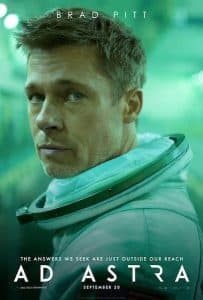Ad Astra | Movie Review

In 1961, President John F. Kennedy said it should be America’s goal to put a man on the moon “before this decade is out.” In the 2010s, it seems someone told star directors that they should make as many films set in space as they can in this decade, with filmmakers like Ridley Scott, Christopher Nolan, Damien Chazelle and Alfonso Cuarón answering that hypothetical call.
James Gray, a big name among cinephiles but not with most moviegoers, is the latest to tackle space with “Ad Astra.” His effort is among the better science fiction films in recent memory, though it can be a tough nut to crack.
Set in an unspecified near future, the film centers on Brad Pitt as Roy McBride, an astronaut famous for his heartbeat never going about 80 beats per minute on a mission. After a freak electric storm hits Earth, McBride is tasked with getting a message to his father (played by Tommy Lee Jones), an astronaut who went on a mission to Neptune and disappeared years ago but is now presumed alive.
Although others make appearances in “Ad Astra,” this is Pitt’s movie and he excels in the role. For about the first half of the picture, his character is withdrawn and subdued and Pitt plays that expertly, allowing the slimmest rays of humanity to leak through to give the audience something to invest in.
As the narrative unfolds and Roy becomes more open, Pitt does so too, slowly, perfectly allowing us in. It’s great work in a completely different key than his magnificent turn in “Once Upon a Time…in Hollywood” earlier this year.
As good as he is, Pitt is outclassed by the stellar visuals in the film from
Gray, cinematographer Hoyte Van Hoytema and the visual effects team led by
Allen Maris. During the times when audiences may struggle to engage with the
film, it’s the visual element that keeps moviegoers enthralled.
There are scenes of staggering beauty in the film, such as a shot where Roy lifts his hand to allow some moon dust to drift through his fingers. Gray’s camera is also consistently engrossing, giving us a terrific mix of close-ups on Pitt’s lined face and wider shots of the cosmos and the places in it.
Gray also excels with the few action set pieces the film offers, which are genuinely suspenseful and expertly staged. The opening scene is thrilling. A chase sequence at Roy’s fist stop on his mission is a brilliant mix of old-school action and futuristic fun. A scene on another spaceship later in the film is like something out of a horror movie. And all these scenes are paced well to give brief instances of excitement in an otherwise low-key film.
“Ad Astra” is also remarkable for all the ideas it has on its mind. The script, written by Gray and Ethan Gross, is about fathers and sons, emotional vulnerability, traditional masculinity, among other themes. Gray and Gross have those themes play out subtly, giving you plenty to chew on longer after the credits roll.
With all that being said, those interested in the film should know it is not a typical space epic. Gray’s film is much more introspective and idiosyncratic than many others of its kind. It has a Malickian voiceover that conveys much of about Pitt’s character and emotional state, but that I found hard to connect with.
“Ad Astra” overall has that issue as it is a bit withdrawn and cold, perhaps to mirror its protagonist. It can be hard to invest with on an emotional level and engage with intellectually because of that iciness, but there is plenty of text and subtext at play that should make the film rewarding on repeat viewings. It will also probably be more accessible the more times you watch it.
But, even on that first viewing, “Ad Astra” ranks as one of the better movies of 2019. I give it 3.5 out of 5 stars.
Ad Astra is Rated PG-13 for some violence and bloody images and for brief strong language. It stars Brad Pitt, Tommy Lee Jones, Ruth Negga and Liv Tyler and runs 2 hours and 3 minutes.





